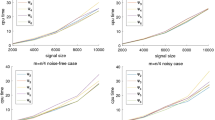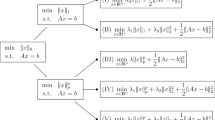Abstract
\({L}_0\) norm plays a crucial role in sparse optimization, but discontinuities and non-convexity make the minimization of the \({l}_0\) norm be an NP-hard problem. To alleviate this problem, we design a smoothing function based on the sigmoid function to approximate the \({l}_0\) norm. To illustrate the physical realizability of the smoothing function and the advanced quality of the approximation, the proposed smoothing function is compared experimentally with several existing smoothing functions. Additionally, we analyze the parameters in the functions to determine the quality of the approximation. We investigate the circuit implementation of the proposed function and five existing smoothing functions; the simulation results show the effectiveness of the designed circuit on the Multisim platform. Experiments on the reconstruction of simulated sparse signals and real image data show that the proposed smoothing function is able to reconstruct sparse signals and images with lower mean square error (MSE) and higher peak signal-to-noise ratio (PSNR), respectively.



























Similar content being viewed by others
Data availability
The datasets generated during the current study are available from the corresponding author upon reasonable request.
Code availability
All codes generated during the study appear in https://github.com/123d-com/L0-norm.git.
References
D. Adil, R. Peng, S. Sachdeva. Fast, provably convergent irls algorithm for p-norm linear regression. In: Advances in Neural Information Processing Systems, vol. 32 (2019). https://proceedings.neurips.cc/paper/2019/file/46c7cb50b373877fb2f8d5c4517bb969-Paper.pdf
T. Blumensath, M.E. Davies, Gradient pursuits. IEEE Trans. Signal Process. 56(6), 2370–2382 (2008). https://doi.org/10.1109/TSP.2007.916124
H. Boche, R. Calderbank, G. Kutyniok, J. Vybíral (eds.): Compressed Sensing and Its Applications: MATHEON Workshop 2013, 1st ed. 2015 edn. Applied and Numerical Harmonic Analysis. Springer, Cham (2015). https://doi.org/10.1007/978-3-319-16042-9
P.T. Boufounos. Greedy sparse signal reconstruction from sign measurements. in: 2009 Conference Record of the Forty-Third Asilomar Conference on Signals, Systems and Computers, pp. 1305–1309 (2009). https://doi.org/10.1109/ACSSC.2009.5469926
H. Che, J. Wang, A. Cichocki. Bicriteria sparse nonnegative matrix factorization via two-timescale duplex neurodynamic optimization. IEEE Trans. Neural Netw. Learn. Syst., 1–11 (2021). https://doi.org/10.1109/TNNLS.2021.3125457
H. Che, J. Wang, A. Cichocki, Sparse signal reconstruction via collaborative neurodynamic optimization. Neural Netw. 154, 255–269 (2022). https://doi.org/10.1016/j.neunet.2022.07.018
H. Che, J. Wang, W. Zhang, A collaborative neurodynamic approach to sparse coding, in Advances in Neural Networks - ISNN 2019. ed. by H. Lu, H. Tang, Z. Wang (Springer, Cham, 2019), pp.454–462
W. Chen, M. Huang, W. Ye, X. Lou, Cascaded form sparse fir filter design. IEEE Trans. Circuits Syst. I Regul. Pap. 67(5), 1692–1703 (2020). https://doi.org/10.1109/TCSI.2020.2964568
C. Dai, H. Che, M.-F. Leung, A neurodynamic optimization approach for l1 minimization with application to compressed image reconstruction. Int.J. Artif. Intell. Tools 30(01), 2140007 (2021). https://doi.org/10.1142/S0218213021400078
I. Dassios, D. Baleanu, Optimal solutions for singular linear systems of caputo fractional differential equations. Math. Methods Appl. Sci. 44(10), 7884–7896 (2021). https://doi.org/10.1002/mma.5410
I. Dassios, K. Fountoulakis, J. Gondzio, A preconditioner for a primal-dual newton conjugate gradient method for compressed sensing problems. SIAM J. Sci. Comput. 37(6), 2783–2812 (2015). https://doi.org/10.1137/141002062
I.K. Dassios, Analytic loss minimization: Theoretical framework of a second order optimization method. Symmetry (2019). https://doi.org/10.3390/sym11020136
C. Guo, Q. Yang, A neurodynamic optimization method for recovery of compressive sensed signals with globally converged solution approximating to \(l_{0}\) minimization. IEEE Trans. Neural Netw. Learn. Syst. 26(7), 1363–1374 (2015). https://doi.org/10.1109/TNNLS.2014.2341654
Z. Guo, J. Wang. A neurodynamic optimization approach to constrained sparsity maximization based on alternative objective functions. in: The 2010 International Joint Conference on Neural Networks (IJCNN), pp. 1–8 (2010). https://doi.org/10.1109/IJCNN.2010.5596553
M.M. Hyder, K. Mahata, An improved smoothed \(\ell ^0\) approximation algorithm for sparse representation. IEEE Trans. Signal Process. 58(4), 2194–2205 (2010). https://doi.org/10.1109/TSP.2009.2040018
Y. Ji, W.-P. Zhu, B. Champagne, Recurrent neural network-based dictionary learning for compressive speech sensing. Circ. Syst. Signal Process. 38(8), 3616–3643 (2019). https://doi.org/10.1007/s00034-019-01058-5
A. Jiang, H.K. Kwan, Y. Zhu, X. Liu, N. Xu, Y. Tang, Design of sparse fir filters with joint optimization of sparsity and filter order. IEEE Trans. Circuits Syst. I Regul. Pap. 62(1), 195–204 (2015). https://doi.org/10.1109/TCSI.2014.2354771
S.G. Lingala, M. Jacob, Blind compressive sensing dynamic mri. IEEE Trans. Med. Imaging 32(6), 1132–1145 (2013). https://doi.org/10.1109/TMI.2013.2255133
X. Liu, J. Wang, An analog circuit design for k-winners-take-all operations, in Neural Inf. Process. ed. by L. Cheng, A.C.S. Leung, S. Ozawa (Springer, Cham, 2018), pp.666–675
M.R. Mohammadi, E. Fatemizadeh, M.H. Mahoor, Non-negative sparse decomposition based on constrained smoothed l0 norm. Signal Process. 100, 42–50 (2014). https://doi.org/10.1016/j.sigpro.2014.01.010
D. Needell, J.A. Tropp, Cosamp: Iterative signal recovery from incomplete and inaccurate samples. Appl. Comput. Harmon. Anal. 26(3), 301–321 (2009). https://doi.org/10.1016/j.acha.2008.07.002
W.O. Popoola, Z. Ghassemlooy, C.G. Lee, A.C. Boucouvalas, Scintillation effect on intensity modulated laser communication systems-a laboratory demonstration. Opt. Laser Technol. 42(4), 682–692 (2010). https://doi.org/10.1016/j.optlastec.2009.11.011
U. Saeed, A survey of automatic person recognition using eye movements. Int. J. Pattern Recognit. Artif. Intell. 28(08), 1456015 (2014). https://doi.org/10.1142/S0218001414560151
M. Storace, M. Parodi, D. Pastorino, V. Tripodoro, A method for defining analog circuits for the minimization of discrete functionals: An image processing application. Circ. Syst. Signal Process. 18(5), 457–477 (1999). https://doi.org/10.1007/BF01387466
M. Taher Abuelma’atti, Universal cmos current-mode analog function synthesizer. IEEE Trans. Circu. Syst. I Fundam. Theory Appl. 49(10), 1468–1474 (2002). https://doi.org/10.1109/TCSI.2002.803356
J.A. Tropp, A.C. Gilbert, Signal recovery from random measurements via orthogonal matching pursuit. IEEE Trans. Inf. Theory 53(12), 4655–4666 (2007). https://doi.org/10.1109/TIT.2007.909108
S. Uenohara, K. Aihara, Time-domain digital-to-analog converter for spiking neural network hardware. Circuits Syst. Signal Process. 40(6), 2763–2781 (2021). https://doi.org/10.1007/s00034-020-01597-2
J. Wang, X.T. Wang, Sparse approximate reconstruction decomposed by two optimization problems. Circuits Syst. Signal Process. 37(5), 2164–2178 (2018). https://doi.org/10.1007/s00034-017-0667-6
L. Wang, P. Ye, J. Xiang. A modified algorithm based on smoothed l0 norm in compressive sensing signal reconstruction. In: 2018 25th IEEE International Conference on Image Processing (ICIP), pp. 1812–1816 (2018). https://doi.org/10.1109/ICIP.2018.8451799
J. Xiang, H. Yue, X. Yin, G. Ruan, A reweighted symmetric smoothed function approximating l0-norm regularized sparse reconstruction method. Symmetry (2018). https://doi.org/10.3390/sym10110583
H. Xue, Y. Song, Non-convex approximation based l0-norm multiple indefinite kernel feature selection. Appl. Intell. 50(1), 192–202 (2020). https://doi.org/10.1007/s10489-018-01407-y
Acknowledgements
This work is supported by the Fundamental Research Funds for the Central Universities (Grant No. SWU020006), National Natural Science Foundation of China (Grant Nos. 6200 3281, 62103428), Natural Science Foundation of Chongqing, China (Grant No. cstc2021jcyj-msxmX1169), and Natural Science Fund of Hunan Province (Grant No. 2021JJ40702).
Author information
Authors and Affiliations
Corresponding author
Ethics declarations
Conflict of interest
The authors declare that they have no known competing financial interests or personal relationships that could have appeared to influence the work reported in this paper.
Additional information
Publisher's Note
Springer Nature remains neutral with regard to jurisdictional claims in published maps and institutional affiliations.
Rights and permissions
Springer Nature or its licensor (e.g. a society or other partner) holds exclusive rights to this article under a publishing agreement with the author(s) or other rightsholder(s); author self-archiving of the accepted manuscript version of this article is solely governed by the terms of such publishing agreement and applicable law.
About this article
Cite this article
Li, J., Che, H. & Liu, X. Circuit Design and Analysis of Smoothed \({l}_0\) Norm Approximation for Sparse Signal Reconstruction. Circuits Syst Signal Process 42, 2321–2345 (2023). https://doi.org/10.1007/s00034-022-02216-y
Received:
Revised:
Accepted:
Published:
Issue Date:
DOI: https://doi.org/10.1007/s00034-022-02216-y




